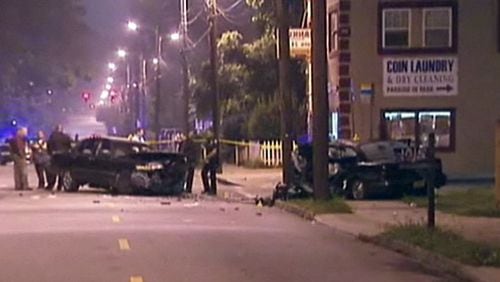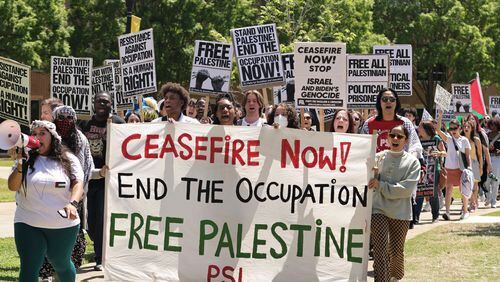Recently, I visited Pittsburgh, the neighborhood just south of downtown, to get a primer on crime in Atlanta.
It’s in Pittsburgh, on McDaniel Street, that an ugly convenience store in recent years became an emblem of societal breakdown, a corner where punks with Glocks (and AK-47s) came to get it on.
But police have announced a crackdown on rising violence.
Back in 2014, after another crackdown, I canvassed a two-block stretch of McDaniel and found just six of 24 homes occupied. A 2013 city report found a third of the community’s 1,571 residences were vacant.
On this visit, I came across a large fellow in a black sedan, perpetually on a cellphone. His name was Greg Hightower. His mission: Fill up some of the vacant houses blighting this community.
“I sell to homeowners,” he said. “I did eight houses in the last two years. This neighborhood is trying to turn.”
Sure, I figured. Guys selling houses also peddle enthusiasm.
We knocked on the door of a newer home near the store, a house vacant last time I visited. Devon Holloway answered, looking a bit vigilant.
His initial wariness is understandable. The sound of gunshots at night is not uncommon, he said. The IT consultant and single father said he bought the two-story home from Hightower this year for $117,000. Hightower renovated and sold the home next door and is doing the same across the street.
Holloway moved into the Old Fourth Ward in 1996 and became a community leader in what is now Atlanta’s Hot ‘Hood, what with the Beltline stretching through its backyard. He’s hoping the same lightning will strike Pittsburgh. The Beltline is planned there, too.
Down the street was Bruce Boyd in front of a home that, in real estate parlance, has potential. Boyd, 59, was born in Pittsburgh and recalls a "thriving community with doctors' offices and everything."
In 1970, there were 7,300 residents. Today, perhaps 3,500.
The historic black community has had its boosters, including various city agencies, Habitat for Humanity and the Annie E. Casey Foundation. Private investors swooped in a decade ago, gobbling up properties, driving up prices and renovating. Homes sold for up to $300,000. But much of that was mortgage fraud. And what followed was perhaps the city’s worst foreclosure rate.
“I think a lot of people lost heart when the Big Crash happened,” Boyd said. Vacant homes were vandalized and stripped and became crime incubators.
“If they get crime down, people will come back,” he said.
To an extent, buyers are returning. Average home prices plunged from $84,972 in 2006 to $13,241 in 2012, according to the real estate research firm SmartNumbers. Now the average is $61,800, although many buyers seem to be investors waiting for the next land rush.
In the past six years the city has bought 34 homes and renovated 12 of them, although just two have sold. The others are rented. In the next year, the city will fix up nine properties on Garibaldi Street, with the idea that clustering renovations creates momentum.
The Casey Foundation has acquired 53, sold eight and is rehabbing six more near an elementary school.
“We lost money on every home we sell,” said the foundation’s Natallie Keiser. “That’s why you’re not seeing a lot of private development.”
William Murray bought a funeral home on McDaniel Street a decade ago. His wife thought he had lost his mind, although he makes a living. (A wake was being held for a teen gunshot victim from DeKalb County the day I visited.)
“There is only so much the city can do. The people have to do it,” said Murray. “To lift a neighborhood, you need private money.”
What has driven the rebirth of other neighborhoods is private citizens making individual, house-by-house decisions until there’s a positive tipping point.
Pittsburgh has not yet reached its tipping point. But in one afternoon, I found about half a dozen new residents willing to fill that bill — young, educated, African-American, and motivated for change.
Jasper Barnes, an Emory University professional, bought a two-story new construction in 2009 for $85,000. The home had once sold for $285,000, so he figured he had a bargain.
“I saw this as the last hidden jewel in the city,” he said. “I wanted to be on the Beltline and was looking for an investment.”
His became the only occupied home of nine on a dead-end block of Hubbard Street. His house was broken into eight times in 18 months. But now all the homes are renovated and the last two are for sale. The break-ins have stopped.
Sohna Harzeez, who works for the school system, came to the area in 2013.
“I didn’t want a cookie-cutter neighborhood; I wanted a place I could get in on the ground floor and get my hands dirty,” said the former Cobb County resident.
Check. Check. Check.
Harzeez’s relatives had the same reaction as the funeral director’s wife — they thought she was crazy.
“I probably should have had more fear, been more cautious,” she said. “But it allowed me to jump in and do the work.”
Now Pittsburgh needs some more brave, motivated souls.
About the Author







